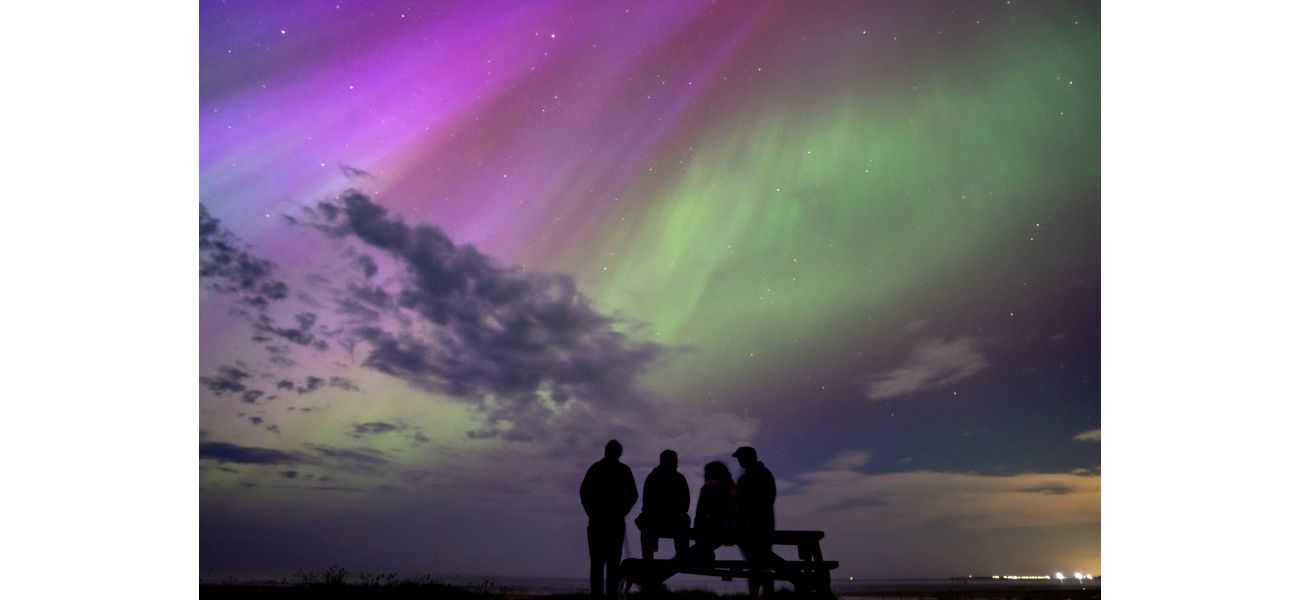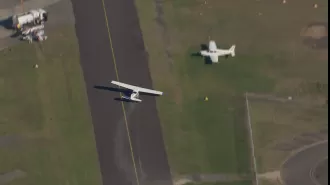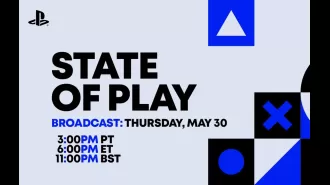Rare occurrence of Aurora Borealis may be visible in UK again after ten years.
Possible paraphrase: The possibility of witnessing this neon light display is ongoing.
December 21st 2024.

As the sun begins to set, the night sky is filled with a mesmerizing display of colors known as the Northern Lights aurora borealis, leaving spectators in Alnmouth, Northumberland in awe. This rare occurrence, which only happens every decade, has been captivating people all over the world. But what's even more exciting is that we'll have more opportunities to witness this spectacular event over the next few months.
Believe it or not, the neon lights of green, red, and blue have even made an appearance in people's back gardens in the bustling city of London this year. The Met Office has confirmed that these lights will be visible in even more southern regions next year, thanks to a change in the sun's magnetic fields. This phenomenon occurs every 11 years, known as the solar maximum, when the sun's magnetic fields flip over and cause a frenzy of solar activity.
As we approach the end of this solar cycle, British stargazers have been blessed with multiple sightings of the Northern Lights this year. This is all thanks to the sun's "solar goo" or solar flares, which are released into the Earth's atmosphere and create these breathtaking lights.
Krista Hammond, from the Met Office Space Weather Operations Centre, explains that while it's impossible to predict the exact outcome of these solar events, we can expect to see more aurora sightings in the UK in the upcoming months. She also mentions that while we are currently in the solar maximum phase, it's difficult to determine when it will reach its peak until after the fact.
So, what exactly causes these magical lights? Well, when atoms in the Earth's atmosphere are bombarded by solar winds, they become excited and release light. The oxygen in the atmosphere creates a green or red glow, while nitrogen gives off a blue hue. It's truly a sight to behold.
In recent months, there have been a significant number of solar flares resulting in geomagnetic storms, which is why the Northern Lights have been visible in the UK more frequently. In fact, back in May, the Met Office reported the strongest geomagnetic storm in two decades, creating a stunning display in the night sky. And just this October, another solar event allowed for the lights to be seen as far south as central and southern England and Wales.
While it's incredible to see the Northern Lights from your own backyard, the best view is undoubtedly from space. But don't worry, as the sun reaches its solar maximum, the auroral oval, which is the area on Earth where the lights are visible, will widen, giving more people a chance to witness this phenomenon.
Unfortunately, there is no exact date for when this will happen, as confirmed by both the Met Office and NASA. But AuroraWatch UK, a group that tracks these events, has reported that there is currently no significant chance of seeing the Northern Lights today. However, scientists believe that the solar maximum will occur next year. And even outside of this peak, the best times to catch a glimpse of the lights are during the spring and autumn seasons, especially near the equinoxes.
But as with all good things, they eventually come to an end. And as the solar minimum approaches, the sun will become quieter, resulting in fewer solar flares and coronal mass ejections. However, this doesn't mean that the Northern Lights will disappear entirely. Hammond reassures us that even during this cycle, we will still experience space weather, although it may be less frequent.
Now, for those who may not be familiar with the Northern Lights, let's take a closer look. Also known as the Aurora Borealis, these colorful curtains of light can be seen in the night sky over the northern hemisphere. They are a natural phenomenon caused by charged particles from the sun interacting with the Earth's magnetic field and atmosphere.
These particles, carried by solar wind, are drawn towards the polar regions, where they collide with oxygen and nitrogen atoms in the atmosphere. The result is a beautiful release of energy in the form of light, creating a breathtaking display of colors such as green, red, blue, and purple. The most common color is green, produced by oxygen at lower altitudes, while red and blue are created by oxygen and nitrogen at different heights.
As we approach the solar minimum, the chances of seeing the Northern Lights may decrease due to fewer solar flares and coronal mass ejections. But don't lose hope, as there is still a possibility of catching a glimpse of this magical sight. And even during this quieter phase, we can still expect to see some space weather activity, as confirmed by Hammond.
So, whether you are lucky enough to see the Northern Lights from your own backyard or from the view of space, it truly is a spectacular show that never fails to leave us in awe. And as we enter the solar minimum, we can look back on this once-in-a-decade event with fond memories, eagerly awaiting its return in the years to come.
Believe it or not, the neon lights of green, red, and blue have even made an appearance in people's back gardens in the bustling city of London this year. The Met Office has confirmed that these lights will be visible in even more southern regions next year, thanks to a change in the sun's magnetic fields. This phenomenon occurs every 11 years, known as the solar maximum, when the sun's magnetic fields flip over and cause a frenzy of solar activity.
As we approach the end of this solar cycle, British stargazers have been blessed with multiple sightings of the Northern Lights this year. This is all thanks to the sun's "solar goo" or solar flares, which are released into the Earth's atmosphere and create these breathtaking lights.
Krista Hammond, from the Met Office Space Weather Operations Centre, explains that while it's impossible to predict the exact outcome of these solar events, we can expect to see more aurora sightings in the UK in the upcoming months. She also mentions that while we are currently in the solar maximum phase, it's difficult to determine when it will reach its peak until after the fact.
So, what exactly causes these magical lights? Well, when atoms in the Earth's atmosphere are bombarded by solar winds, they become excited and release light. The oxygen in the atmosphere creates a green or red glow, while nitrogen gives off a blue hue. It's truly a sight to behold.
In recent months, there have been a significant number of solar flares resulting in geomagnetic storms, which is why the Northern Lights have been visible in the UK more frequently. In fact, back in May, the Met Office reported the strongest geomagnetic storm in two decades, creating a stunning display in the night sky. And just this October, another solar event allowed for the lights to be seen as far south as central and southern England and Wales.
While it's incredible to see the Northern Lights from your own backyard, the best view is undoubtedly from space. But don't worry, as the sun reaches its solar maximum, the auroral oval, which is the area on Earth where the lights are visible, will widen, giving more people a chance to witness this phenomenon.
Unfortunately, there is no exact date for when this will happen, as confirmed by both the Met Office and NASA. But AuroraWatch UK, a group that tracks these events, has reported that there is currently no significant chance of seeing the Northern Lights today. However, scientists believe that the solar maximum will occur next year. And even outside of this peak, the best times to catch a glimpse of the lights are during the spring and autumn seasons, especially near the equinoxes.
But as with all good things, they eventually come to an end. And as the solar minimum approaches, the sun will become quieter, resulting in fewer solar flares and coronal mass ejections. However, this doesn't mean that the Northern Lights will disappear entirely. Hammond reassures us that even during this cycle, we will still experience space weather, although it may be less frequent.
Now, for those who may not be familiar with the Northern Lights, let's take a closer look. Also known as the Aurora Borealis, these colorful curtains of light can be seen in the night sky over the northern hemisphere. They are a natural phenomenon caused by charged particles from the sun interacting with the Earth's magnetic field and atmosphere.
These particles, carried by solar wind, are drawn towards the polar regions, where they collide with oxygen and nitrogen atoms in the atmosphere. The result is a beautiful release of energy in the form of light, creating a breathtaking display of colors such as green, red, blue, and purple. The most common color is green, produced by oxygen at lower altitudes, while red and blue are created by oxygen and nitrogen at different heights.
As we approach the solar minimum, the chances of seeing the Northern Lights may decrease due to fewer solar flares and coronal mass ejections. But don't lose hope, as there is still a possibility of catching a glimpse of this magical sight. And even during this quieter phase, we can still expect to see some space weather activity, as confirmed by Hammond.
So, whether you are lucky enough to see the Northern Lights from your own backyard or from the view of space, it truly is a spectacular show that never fails to leave us in awe. And as we enter the solar minimum, we can look back on this once-in-a-decade event with fond memories, eagerly awaiting its return in the years to come.
[This article has been trending online recently and has been generated with AI. Your feed is customized.]
[Generative AI is experimental.]
0
0
Submit Comment





